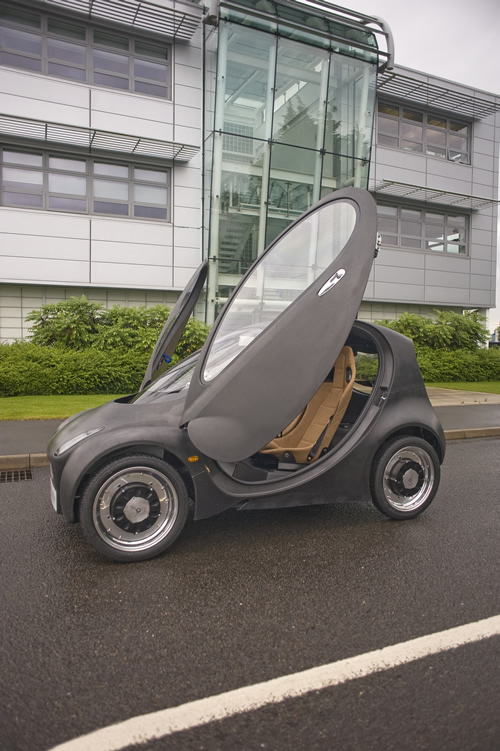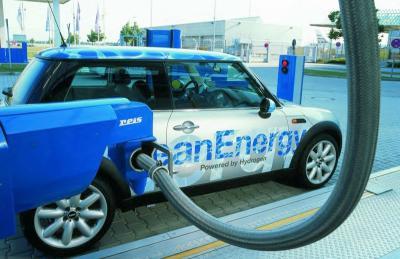If you've read this site for more than five minutes you know I believe it's better to spend money researching legitimate clean energy rather than porkbarrelling environmental activism darlings like ethanol, wind energy, solar panels and CFL bulbs. Hydrogen fuel-cell vehicles can not only be an important part of the solution to America's energy crisis, they can eliminate it ... but challenges remain.
A hydrogen fuel cell vehicle is like today's electric cars but instead of the current horrid feel-good technology which trades CO2 for acid rain in the manufacturing and disposal of the batteries, future fuel cells will convert pure hydrogen and oxygen into electricity.
There are three challenges for any fuel system that wants to replace gasoline. If you're one of those people who insists people have to change their ways rather than have technology that accomodates them, save your time. It isn't going to happen. We're not a stone-age tribe and even when we were a stone-age tribe no one listened to people who said we had to ration food when game ran short. Scientists instead invented agriculture and scientists will solve this problem as well. The ABCs of hydrogen fuel cell requirements are:
A) People want to be able to go 300 miles. In all the whining about Big Auto supposedly killing the perfect electric car in the 1990s, what is left out of documentaries is that they were dangerous and they only went 60 miles - a fine solution for Hollywood celebrities with multiple cars but not most commuters. Make it 300 miles and it will sell, but that leads to ...
B) Storage. To go 300 miles with today's admittedly less efficient hydrogen methods, you need a tank the size of a double-decker bus or you need to compress it. Compressed hydrogen can take you to a weird place quickly if something goes wrong.
C) Time. Few people want to stand around for 30 minutes while their car refuels, although it would be a wonderful thing for truck stops and getting to know your fellow man on road trips. Still, we're not in the social engineering business.
There are ways where hydrogen vehicles can work now, namely in government jobs. Let's face it, the efficiency and cost loss of hydrogen vehicles are not the worst thing governments will waste money on. Basel, Switzerland is testing the hydrogen-powered Bucher CityCat H2, basically just a giant street sweeper, but it's something they can use to test durability of components and practicality of technology.

1. The Riversimple Urban car currently in limited prototype in London is a little more suitable for small European parking spaces. It isn't cheap but economies of scale will conquer that assuming demand and quality (and keeping the government out of it).
Bonus: it was created using open source technology! So your kids will some day build their own.

2. If we want to really get crazy, take a look at this "In Vitro Synthetic Biology' Hydrogen Process" - yes, they are pursuing sugar-fueled cars.
But it can go even further than that. A company called Isis Innovations is prototyping biological fuel cells. Now, biological fuel cells may sound like a step backward - when I was in the army, we told foot soldiers they would be travelling using LPCs, Leather Personnel Carriers (their boots, if you haven't had your coffee yet) but acronyms sounded better. So biological power to you may mean ...

No, this hydrogen technology uses enzymes for a catalyst rather than expensive metal like platinum. Bring on the cyanobacteria!
3. Titanium dioxide can even be involved. You may have heard of titanium dioxide because Energy Secretary Steven Chu said a short while ago that people should paint their roofs white. Yes, it took a Nobel prize and an entire US government to say what everyone already knew. It still gave activists the vapors and a chance to say that Obama is sooooo much better for science despite any actual work yet. But he's right, in the same way your grandparents knew. Even better, titania nanotubes may some day allow us to convert water into hydrogen using solar energy - a clean energy trifecta!
4. Pillared graphene hopes to take the danger out of hydrogen storage, though it may sound a little scary at first. Graphene sheets — layers of carbon just one atom thick —will be stabilized by vertical columns of carbon nanotubes. Pillared graphene could theoretically store up to 41 grams of hydrogen per liter, which nearly matches the DOE target of 45 grams but it has a way to go.

Finally, let's get back to the unstable materials I mentioned in the first paragraph to round out our 5 ways to achieve a hydrogen economy.
5. Complex hydride LiBH4 technology says it can solve all three of the consumer-comfort requirements above. Right now its thermodynamic properties require high temperatures to release hydrogen, hardly a practical, cost-effective or safe solution. But materials are where the research will need to go in order to have hydrogen storage safe enough for your kids yet cost-effective enough people will buy them.
Additional hydrogen fuel cell vehicle updates:
* Toyota recently made the 350-mile drive from Osaka to Tokyo expending only 70 percent of the fuel supply of a current FCV technology. Masatami Takimoto, vice president with the company said, ""Toyota Motors is planning on releasing a fuel-cell car by 2015 in its attempt to retain its lead in the global race for green cars."
* Honda's FCX Clarity was recently chosen as 2009 World Green Car. They say its fuel efficiency is three times that of a conventional auto and double that of gasoline-powered hybrids. Volkswagen and GM both have laid claim to hydrogen technology appearing in 2012 but I haven't seen anything more than press releases on those.




Comments